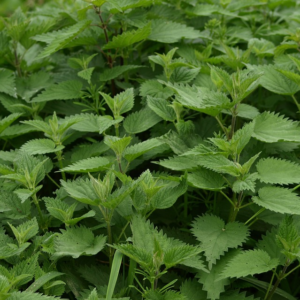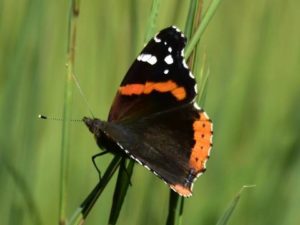Table of Contents
Stinging Nettle Herb
(Urtica dioica)
Alias names for Nettle herb: Nettles, Nettle leaf, Nettle herb, Urtica dioica, pot herb, dwarf nettle, Burn weed, Garden nettle, (French) L’Ortie, (German) Brenn-Nessel (Note: The Latin root of Urtica is uro or urere meaning “to burn”.)

Patch of nettles herb (Urtica dioica) in the spring.
Picture of Nettle herb:
References for Nettle herb pictures: https://hikersnotebook.net/Stinging+Nettle
About Nettle herb:
According to Roman times, Roman nettle was used for arthritis and rheumatism in a process called urtication where the cut stalks were bundled and flailed onto the back. Ouch! American Indians used it as one of spring’s first cooked vegetable and as a spring tonic (the cooking process inactivates the sting).
Nettles contain histamine and formic acid in the hairs that trigger that familiar allergic response in the body. The leaves are collected when young in the spring and the roots are harvested in the fall.
I’ve seen herbalists harvest nettles with no gloves on and with no apparent issues with the sting part of the nettle. The tough fibers of nettle have been used in making clothing (burial shrouds) and rope/twine. The herb can be used to dye wool (green). The vegetable part has also been used to make nettle beer and the chlorophyll is used in shampoo/conditioner.
Plants are processed commercially for extraction of chlorophyll which is used as coloring agents in foods and in medicines.
Historical Uses of Nettle herb and How it Works:
- Allergies
- Anemia (as a tonic high in iron and vitamin C)
- Arthritis
- Benign Prostate Hyperplasia
- Bites, insect
- Burns
- Coughs
- Diuretic
- Eczema and other skin issues
- Gout relief (clears uric acid from the body)
- Hay Fever
- Hemorrhoids (apply ointment)
- Insect wounds
- Itchy eyes (hay fever)
- Kidney Stones
- Neuralgia
- Nosebleeds (inhale powdered herb as snuff)
- Pregnancy and Post-Partum support
- Sciatica
- Sinusitis
- Sprains
- Stimulates hair growth
- Stops bleeding (because it’s and astringent)
- Tendinitis
- Tuberculosis
- Urinary Tract Infections
- Uterine bleeding
Parts of Nettle herb Plant Used: Dried or fresh leaves and stalks as dried herb or in juice, as tea, as a vegetable, in tinctures, hair rinses, compresses and ointments. The nettles roots are used as a conditioner for hair loss and dandruff. Harvest young leaf tips from the plant when it is less than 4 inches tall before it develops oxalate crystals. These calcium oxalate crystals make for a gritty texture even after being cooked.
Properties of Nettle herb: Cool, dry, astringent, slightly bitter, diuretic, tonic, nutritive, stops bleeding, circulatory stimulant, promotes milk flow, lowers blood sugar levels, prevents scurvy, inhibits inflammatory prostaglandin, somehow affects testosterone and estrogen in the body.
Chemical Constituents of Nettle herb: Polysaccharides (complex sugars), lectins, indoles (Histamine and Serotonin), formic acid, acetylcholine, glucoquinones. Nettles are high in silica, iron, chlorophyll and vitamins A, B C and tannins.
Contraindications, safety issues, concerns, harmful drug interactions and allergy precautions for Nettles: May cause mild gastrointestinal upset in some people. Fresh nettles can cause a rash when brushed against the skin. Occasional side effects include mild stomach upset, fluid retention, sweating, diarrhea, and hives or rash (mainly from topical use). Since nettles can cause blood to clot, nettles may interfere with blood thinning drugs. Since nettles can lower blood pressure, taking it orally may interfere with blood pressure medication. Since it is a diuretic beware of also taking Lasix or hydrochlorothiazide diuretics.
Cultivation of Nettle herb: Harvest herb while flowering and roots in the fall. Nettles like moist, nitrogen-rick soil, full sun or partial shade. Propagate via seed sown in the spring or by root rhizome divisions. Nettles are invasive but fairly easy to control. Nettles provide food for caterpillars and various butterflies (Red Admirals).

The red Admiral butterfly feeds on nettles.
Red Admiral butterfly photo reference: https://www.butterfliesandmoths.org/species/Vanessa-atalanta and the caterpillar: https://butterfly-conservation.org/679-823/red-admiral-.html
Nettles bloom June-Sept and grows to between 2-4 feet tall. Flowers are yellow or pink. The leaves are heart-shaped and finely toothed.
Helpful Links and References for Nettle herb:
- Drug interactions with Nettle herb: https://www.umm.edu/health/medical/altmed/herb/stinging-nettle
- Summary of Scientific Studies done with Nettles: https://www.project.nsearch.com/profiles/blogs/medicinal-qualities-of-stinging-nettle